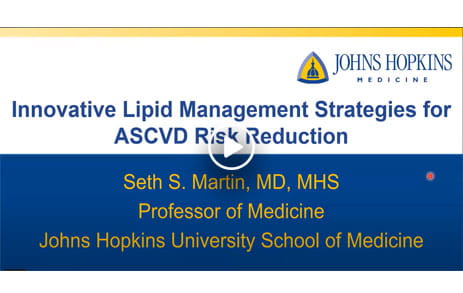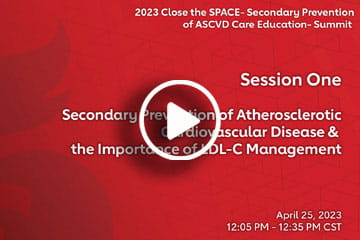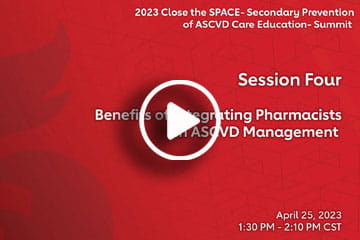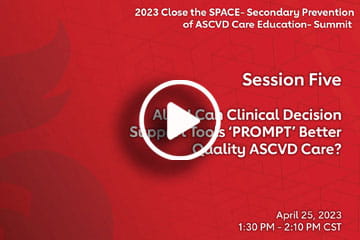
The education connection
Well-organized content structure becomes the linchpin of smooth content flow web pages and enhances the educational impact and engagement for the website user.
- Clear Hierarchy- Ensure that the most important information appears prominently at the top.
- Logical Flow- Arrange content in a logical order. Start with an introduction, followed by main points, and conclude with a summary or call-to-action.
- Visual Elements -Incorporate visuals (images, infographics, videos) to break up text and enhance understanding.
Organized content not only improves user engagement but also contributes to the overall credibility and effectiveness of our websites.
Tab Component
ASCVD Professional Education Tool Kit
Practical Insights of Cholesterol Guidelines for Secondary Prevention of ASCVD
Practical Insights of Cholesterol Guidelines for Secondary Prevention of ASCVD, presented by Salim S. Virani. You will understand and articulate the concepts of thresholds of LDL-C to consider initiation of non-statin lipid lowering therapy, identifying “very high-risk” ASCVD patients and system level gaps in lipid management.
Innovative Lipid Management Strategies for ASCVD Risk Reduction
Learn from leading Cardiology expert Dr. Seth Martin about Innovative Lipid Management Strategies for ASCVD Risk Reduction.
- Recognize the role of a Lipid Clinic in promoting guideline directed medical therapy for ASCVD risk reduction.
- Appreciate evidence supporting the targeting of low LDL-C and importance of modern calculation of LDL cholesterol.
- Recognize the increasing role of digital health technology innovation in lipid management.
- Discuss opportunities to advance health equity and address disparities in lipid management by using new technologies.
Roadmap to ASCVD Treatment
This episode lays the groundwork for our understanding of ASCVD lipid management. Our guest will walk through the algorithm for treatment to guidelines as well as address the barriers, pitfalls, and potential solutions in managing care.
Statin Intensification and Steps to Meeting LDL-C Goal
Secondary Prevention of Atherosclerotic Cardiovascular Disease & the Importance of LDL-C Management
Primary Prevention Insights into Patient Reported ASCVD Barriers
This episode examines the most common patient perceived barriers to treatment and management strategies to overcome these situations in the outpatient/clinic setting.
Download Primary Prevention Insights into Patient Reported ASCVD Barriers transcript (PDF)
Patient Provider Relationships
Our patient Rob, who has been diagnosed with ASCVD, pays a visit to Dr. Salazar to learn more about the patient health care journey he is about to embark upon.
Listen to the Discussion
Download Patient Provider Relationship in the Office transcript (PDF)
Managing and Understanding Cholesterol for ASCVD
Carolyn Dickens, a nurse practitioner that works in cardiology, speaks with Ms. Sharma who recently had a heart attack and is seeking help with making healthier choices as she learns to live with the impact of ASCVD.
Download Managing and Understanding Cholesterol for ASCVD transcript (PDF)
What it Means to Have ASCVD
Dr. Kevin Hwang meets with a patient, Levi, who was recently discharged from the hospital after going to the E.R. with chest pain. In the E.R., they did some EKGs and blood work and diagnosed him with a heart attack. Also, they did a cardiac catheterization, where they found blockages in his arteries, ultimately putting a stent in one of them. Finally, they did a stress test.
Download What it Means to Have ASCVD transcript (PDF)
Tackling ASCVD Through Lifestyle Modifications
Julia Zumpano, a Registered Dietician meets with Kattia to discuss her ASCVD and the effects that her diet and exercise can improve and further prevent future events.
Download Tackling ASCVD Through Lifestyle Modifications transcript (PDF)
Benefits of Integrating Pharmacists in ASCVD Management- Summit (Dr. Michelle Lee Chu)
Looking Ahead in ASCVD- Podcast
Pharmacological ASCVD Management
This episode explores the medications involved in treating hyperlipidemia-related ASCVD from a pharmacist perspective and the common patient misconceptions surrounding these interventions.
Lessons from an Academic Perspective- Sharing Ownership of Reducing ASCVD Risk- Summit (UVA Panel)
Alert! Can Clinical Decision Support Tools ‘PROMPT’ Better Quality ASCVD Care?- Summit (Dr. Ralph Riello)
Guideline-Based Alerts in the Electronic Health Record for ASCVD
Download Guideline-Based Alerts in the EHR for ASCVD transcript (PDF)
The Next Top Model: Activating & Improving Systems of Care- Podcast
ASCVD Management in the Emergency Department
This episode evaluates pathways to identify adults with high ASCVD risk and intervention with lipid-lowering therapy in the Emergency Department
Download ASCVD Management in the Emergency Department transcript (PDF)
#AHA24 Schedule-at-a-Glance All times are Central Standard Time (UTC -6)
| Time | Activity |
|---|---|
| 11:00 a.m. to 6:00 p.m. |
|
| 12:30 p.m. to 5:15 p.m. |
|
| 6:00 p.m. to 9:00 p.m. |
|
| Time | Activity |
|---|---|
| 6:00 a.m. to 7:30 a.m. |
|
| 8:00 a.m. to 11:00 a.m. |
|
| 12:00 p.m to 4:30 p.m. |
|
| 6:00 p.m. to 9:00 p.m. |
|
| Time | Activity |
|---|---|
| 6:00 a.m. to 7:30 a.m. |
|
| 8:00 a.m. to 11:00 a.m. |
|
| 12:00 p.m to 4:45 p.m. |
|
| 6:00 p.m. to 9:00 p.m. |
|
| Time | Activity |
|---|---|
| 6:00 a.m. to 7:30 a.m. |
|
| 8:00 a.m. to 11:00 a.m. |
|
| 12:00 p.m to 4:45 p.m. |
|
| 6:00 p.m. to 9:00 p.m. |
|
Accordion Components
The American Heart Association has created social impact funds that reimagine the approach to community transformation to combat social determinants of health through three key impact lenses focused on results.
By their nature, social determinants of health and their roots in structural legacy systems are interrelated. For example, transportation is often a barrier to accessing health services, and at the same time transportation solutions can impact climate and environmental health.
To clearly address the priority investment categories, the following three areas will shape these targeted efforts, acknowledging that many solutions will make an impact across the outlined topics.
Access to affordable, accessible, culturally appropriate quality health and health care is a fundamental value. In most cases, factors outside the traditional health care system are barriers to a healthy life. The funds focus on overcoming or eliminating these challenges. Investments in access to health care complement our other initiatives, including our advocacy and portfolio work addressing health and health systems as well as synergy with the other SDOH categories.
Examples of access to health and health care social enterprises include but are not limited to those focused on:
-
Innovation and Technology
Health tech, pharm tech, mental health care tech, social/emotional well-being tech and innovation makersAdvancing technologies offer new and scalable solutions, and if designed to address barriers in historically under-resourced communities, can reframe access to health.
-
Service and Transportation Platforms
Companies that improve access and knowledge for nonemergency health care, platforms removing language barriers, nonemergency transportation solutions, racially concordant perinatal and mental health care and employment/training opportunities within the health services industriesSome solutions may be variations of traditional services, such as last-mile transportation or community health workers. Others may create community health ambassadors who provide trusted guidance and navigation. And some may focus on loneliness and connection.
Food security encompasses the full food ecosystem from agriculture to food waste management. Both for-profit and non-profit SMEs in the agribusiness vertical/value chain can lead to better access to affordable, healthy and environmentally sustainable foods.
Examples of food security social enterprises include but are not limited to those focused on:
- Sustainable rural farming
- Urban farming and farming cooperatives
- Logistics
- Processing
- “Agritech”
- Last-mile delivery (B2B and B2C)
- Innovative logistics
- Aquaculture/blue economy
- Healthy food retail
- Institutional meal providers
- Food retailers
- Increased healthy food purchasing power
- Food hubs
- Food waste management
- Mobile markets
Fortunately, significant overlap exists between food security and other SDOH categories, including food industry fair and living wage practices, climate-friendly growing and transportation practices and health care systems food services solutions. The funds will complement other advocacy and portfolio efforts focused on food systems.
Promoting economic stability through expanded educational opportunities, employment programs, banking practices and affordable housing is critical to achieving positive health outcomes.
Examples of economic resiliency and poverty reduction social enterprises include but are not limited to those focused on:
- Vocational training
- Recidivism programs
- Employment programs
- Anti-usury financial services
- Early education
- Affordable housing
- Eviction prevention
- Broadband/internet access
- Reducing the education achievement gap
- Edtech
- Violence prevention
As noted in other categories, opportunities for results across multiple initiatives are significant. Training focused on health sector services or food industry wage practices can benefit economic resiliency and health care access/food security. Our advocacy and portfolio efforts also address many of these issues.
Sitecore is here to help you achieve your goals!
Our goal is to provide a seamless and personalized online experience for the needs of our diverse business audiences. We strive for optimal page layout, components that highlight content and engage website users, and custom experiences that lead the user to a carefully planned and executed digital experience.
Disclaimer: The Brochure/Demo site content was written with the assistance of AHA's Copilot AI.







